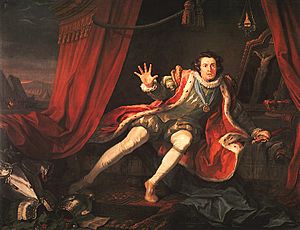Richard III (play) facts for kids
Richard III is a famous history play written by William Shakespeare. He probably wrote it around the year 1593. The play was first printed in a book in 1597.
Like Shakespeare's other history plays, Richard III tells a story about real people and events from England's past. The actual Richard III was king of England from 1483 to 1485. Shakespeare used history books from his own time to create the play. However, many modern experts believe these old histories, and Shakespeare's play, are not completely accurate. They might show a bias against King Richard.
Contents
What is Richard III About?
Richard III is special because its main character is a villain, not a hero. In the play, Shakespeare shows King Richard as a cruel ruler. He does many evil things to gain and keep power.
Richard is eventually defeated in a big battle and killed by Henry Tudor. Henry Tudor then becomes Henry VII of England, the next English king. He was the first king of the Tudor dynasty. The play also uses black comedy, which means it has dark humor. Richard often tells people he is a good person, even while he acts like a villain.
Why Was Richard III Shown as a Villain?
Shakespeare lived and wrote a long time ago, before people had modern ideas about freedom of speech or freedom of the press. The English government at that time controlled what books and plays could be published. This was called censorship.
Queen Elizabeth I of England ruled from 1558 to 1603. She was the granddaughter of Henry VII, the king who defeated Richard III. Her government saw Richard III as a bad guy and Henry VII as a hero. They would not allow any plays or books that showed a different point of view. If Shakespeare had wanted to write a play where Richard III was a hero, he would not have been allowed to.
Richard III in Movies and on Stage
Richard III is still very popular today. A famous movie version was made in 1955. Laurence Olivier directed the movie and also played the main role of Richard.
Many other movies and television shows have been made based on the play. It is also performed often in theaters around the world.
Images for kids
-
Richard III terrified by nightmarish visions. Shakespeare, Act 5, Scene 9, a painting by Nicolai Abildgaard. From the Nivaagaard Collection.
-
David Garrick (1717–1779), as Richard III (from Shakespeare's 'Richard III'), by Nathaniel Dance-Holland (1771).
-
African-American actor James Hewlett as Richard III in a production from about 1821. Below him is a line often added to the play: "Off with his head; so much for Buckingham."
-
The cast of a 2018 production of Richard III at the Abbey Theatre.
See also
 In Spanish: Ricardo III (obra de teatro) para niños
In Spanish: Ricardo III (obra de teatro) para niños










